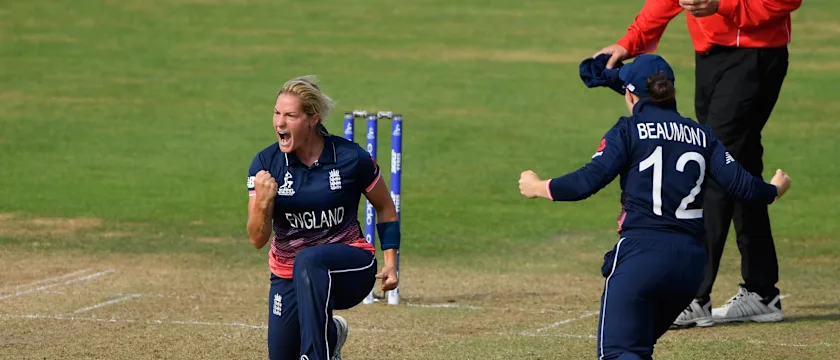Katherine Brunt – still fiery, still scary, still going strong

Katherine Brunt clarifies with a rolling laugh: She doesn’t, in fact, wake her England teammates up at dawn and make them run up the hills with her.
But the sentiment is there.
“I push everyone to work hard,” she tells Wisden India. “I’m the workhorse of the team, I always give it 100 per cent. I work hard on my fitness and my strength. I always make sure I drag people along with me, make sure they’re working as hard as me. It’s really important to me.”
Confirmation of that from her teammates is pending. What they will say, though, is that Brunt is scary. Polite, jovial and the kind of person who has a Twitter feed for her dog (@BaileyBrunt, a chocolate labrador she’s had for five years; “He’s quite the character – a reflection of me actually, he’s a bit crazy!”) but a different person on the cricket green.
This ones @BaileyBrunt 's favourite! 😍 #poser pic.twitter.com/1GaT94q8bS
— Katherine Brunt (@KBrunt26) September 26, 2016
“Scary, mouthy, extremely competitive,” was how she described herself in a video for ICC recently. Growing up, “I used to relish playing with the lads. I used to make them cry, which I really enjoyed.”
She’s the one who wore, almost proudly, a black eye while picking up 3 for 6 in the ICC Women’s World T20 2009 Final. She’s the one the captain throws the ball to in the 47th over of the ICC Women’s World Cup game against a rampant Australia, and who gives you the wickets of Ellyse Perry, her of the consistency, and Alex Blackwell, her of the calm hand, celebrating with a snarl, a roar, a leap and a pumped fist like the most legendary of quicks. She’s the one you want under the catch in the deep in the final over, not because she’s the best fielder, but because she really, really wants to win.
And she’s the one who gave you 259 to defend in the first place, with an entertaining 45 not out in a seventh-wicket stand worth 85. “It was nice to actually bat with Katherine. I haven’t batted with her in ages,” said Jenny Gunn, a fellow veteran who pitched in with 39 and bowled that final over. “It’s still like old times, she still tells me what to do all the time!”
Perry Wicket
“I’m naturally like that,” Brunt says of her fiery nature. “I love what I do. And what I do, fast bowling, is a fiery kind of thing. I get into that zone naturally. I just get in the battle with whoever I’m bowling to and that really helps me.”
It’s almost as if she finds an extra gear against old rival Australia, against whom as a 19-year-old playing only her second ever Test series back in 2005, she took 14 wickets in two games. Ask her what’s behind her longevity, and she’s clear: “My resilience. I love what I do and although I’ve gone through a lot of injuries, I always seem to bounce back from them just because I miss playing so much. I’d say my passion for the game and my resilience to be not back away from injury. I want to move forward.”
India’s Jhulan Goswami, the leading wicket-taker in ODIs, too is a fan of Brunt’s spirit. “I like Brunt,” she said. “She is compact and bowls well in all kind of wickets. She did well on flat wickets in India too. Very positive girl, and never gives up.”
In recent years, though, one of the most fearsome new-ball bowlers in the women’s game has had to work extra hard. Brunt jokes about it and is more than able to go the extra distance, but there’s a tinge of disappointment, if not frustration.
#WWC17 ENG v AUS - Alex Blackwell Innings
“As a bowler, I can tell you, I don’t really like bowling on these flat pitches. The batsmen get it too good,” she laughed after her Player of the Match award for an all-round performance on Sunday.
She’s already remarked how her “job is pretty rubbish really”. Not only are higher totals being posted and chased down in women’s cricket, but also with more teams enjoying pace on the ball, it’s the slower bowlers who have success even in places like Australia and England.
“The wickets that groundsmen seem to be producing are very, very good batting tracks, and it’s very much a batter’s game. It’s never much fun for bowlers,” she explains. “I don’t like it, but it helps you gain a lot of skills, in being able to get people out. So it’s good and bad. A lot of girls wouldn’t have many slower balls at all, [but] 40 per cent of your 10 overs may be slower balls these days just because that’s where it’s going.”
Ask her about the various injuries she’s had to deal with, and she has another deep sigh. “Nobody ever wants to be on the sidelines watching. It’s one of the most difficult things,” she says. “It’s quite debilitating sometimes, to go from being able to do so much to not doing anything. It’s pretty sad. Nobody likes to do it.
“To be able to get back as well, it’s not just doing all the normal training. It’s all the boring things. The rehab is quite monotonous. It’s really hard and it takes a special kind of character to come back from that. For me, it’s important to have the right people around me.”
That Brunt is a special kind of character is in little doubt. On Wednesday, she could play her 100th ODI when England takes on New Zealand, the team she made her international debut against in a 2004 Test. Much has changed in the women’s game since then, as this World Cup has shown. But it’s to the game’s great benefit that it still has its constants, a fiercely competitive Brunt foremost among them.

